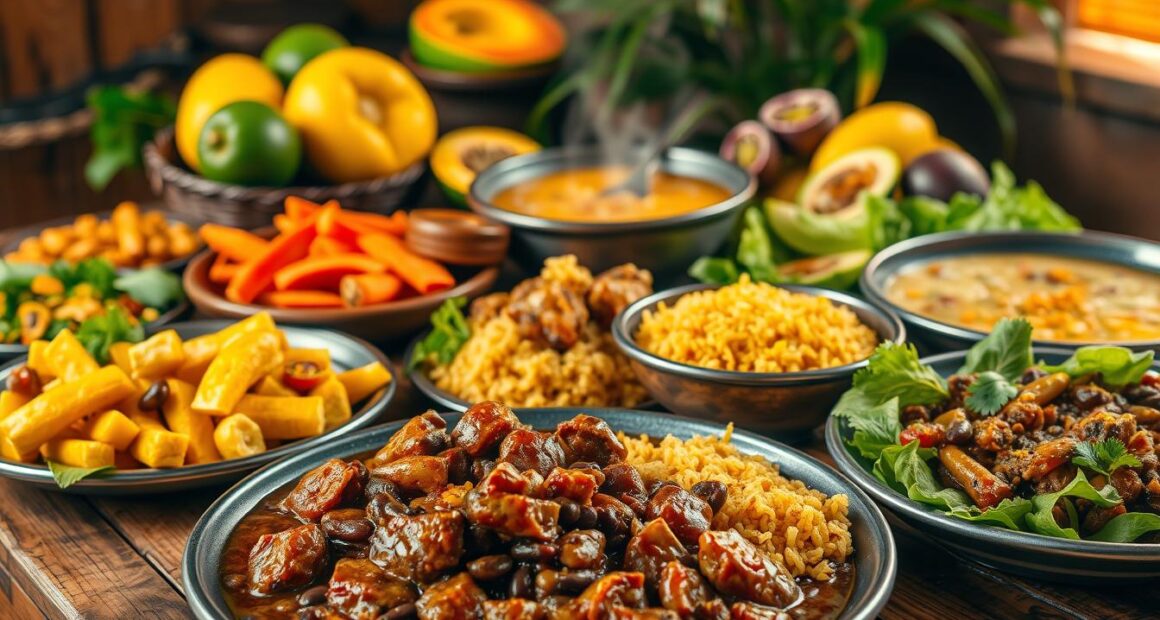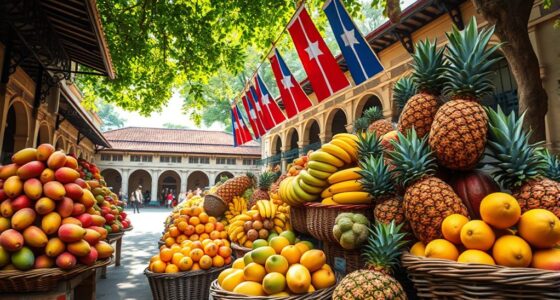Imagine the warmth of family gatherings, where the aroma of rich dishes fills the air, each bite telling a story of love, heritage, and community. That’s the essence of Brazilian cuisine—rooted in cultural traditions and cherished recipes that have transcended generations. For many, like Olivia Mesquita, who moved from São Paulo to New York City in pursuit of a Broadway dream, the kitchen became a refuge—an emotional bridge to her roots. Through her blog, “Olivia’s Cuisine,” she weaves together the vibrant threads of her upbringing, sharing not only traditional Brazilian recipes but also embracing a world of flavors that reflect the multicultural essence of São Paulo. Ready to embark on a culinary journey? Let’s explore the delightful tapestry of Brazilian food culture, turning your kitchen into a hub of warmth, flavor, and connection.
Key Takeaways
- Brazilian cuisine is a blend of diverse cultural influences that shape its unique flavors.
- Traditional Brazilian recipes like feijão tropeiro are vital for maintaining family heritage.
- The preparation of staple ingredients such as rice and beans reflects Brazilian dining habits.
- Gathering around the table is a cherished tradition in Brazilian food culture.
- Olivia Mesquita’s journey emphasizes the emotional ties people have to their culinary backgrounds.
- Exploring Brazilian dishes can enrich your culinary experience and broaden your palate.
- Cooking techniques such as using a pressure cooker are essential in modern Brazilian kitchens.
Introduction to Brazilian Cuisine
Brazilian cuisine represents a delightful fusion of cultures, incorporating elements from Indigenous, African, and European culinary practices. This vibrant mingling of flavors showcases the nation’s rich history and diverse demographics. As you explore Brazilian culinary traditions, you will discover an array of regional specialties, each highlighting local ingredients and customs.
A Rich Cultural Heritage
The culinary landscape in Brazil reflects its historical influences. The primary ingredients used in authentic Brazilian dishes, such as rice and beans, reveal a blend of Indigenous roots and African heritage. This gastronomic melting pot resonates in São Paulo, a city that boasts over 9,000 restaurants and bars, making it the seventh largest gastronomic hub worldwide. The experience of enjoying authentic Brazilian dishes can be found not only in the best Brazilian restaurants but also at home, where traditional flavors and cooking techniques come to life.
Key Ingredients in Brazilian Dishes
Understanding the key ingredients in Brazilian cuisine enriches your culinary journey. Staples like manioc, employed in various forms, are essential in many dishes. Farofa, made from toasted cassava flour, often accompanies meals and adds a unique texture and flavor. Additionally, the use of cachaça in cocktails like caipirinha reflects the vibrant drinking culture, further enhancing the dining experience.
Regional Variations Across Brazil
Brazil’s vast geography results in remarkable regional variations within its culinary traditions. For instance, the South is known for its churrasco, a barbecue culture that highlights red meat due to the region’s livestock economy. Meanwhile, in the Northeast, dishes such as vatapá and acarajé showcase the strong African influence on local cooking. Each region boasts specific local ingredients and cooking techniques, making Brazilian cuisine a true adventure for the senses.
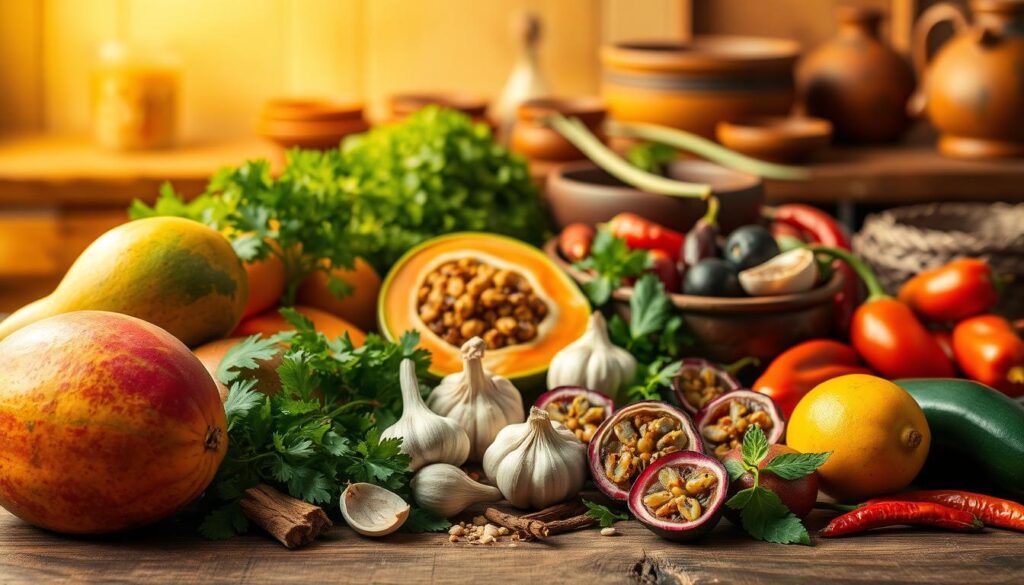
| Region | Signature Dish | Main Ingredients | Cultural Influence |
|---|---|---|---|
| South | Churrasco | Red meat, chimichurri sauce | European (especially German) |
| Northeast | Acarajé | Black-eyed peas, shrimp, vatapá | African |
| Central | Pato no Tucupi | Pato, tucupi sauce | Indigenous |
| North | Jambu | Jambu, fish, local herbs | Indigenous |
Staples of Brazilian Cuisine
The foundation of Brazilian cuisine reflects the diverse culture and traditions of the country. Several staples create the backbone of traditional Brazilian recipes, bringing together flavors and textures that define authentic Brazilian dishes. These three essential components highlight the culinary heart of Brazil.
Rice and Beans: The Heart of Many Meals
Rice and beans stand as the quintessential pairing in Brazilian meals. This duo provides a vital source of protein and carbohydrates, creating a filling and balanced base for a variety of dishes. Often featured in everyday meals, rice and beans serve as a versatile foundation for stews, meats, and salads, making them an indispensable part of Brazilian dining.
Farofa: A Flavorful Accompaniment
Farofa is a beloved side dish made from toasted manioc flour, offering a distinctive crunchy texture. Commonly served with *churrasco* or stews like feijoada, farofa adds depth and flavor, enhancing the overall meal experience. It’s a testament to how Brazilian cuisine embraces simplicity while delivering rich flavors, making it an essential element in traditional Brazilian recipes.
Pão de Queijo: Cheese Bread Delight
Pão de queijo, a delightful cheese bread, showcases Brazil’s love for comfort food. Made from cassava flour and cheese, this popular snack is a favorite among locals and visitors alike. Its crispy exterior and soft, cheesy interior make it a perfect complement to any meal or enjoyed on its own. Pão de queijo emphasizes how authentic Brazilian dishes celebrate familiar ingredients in delicious new ways.
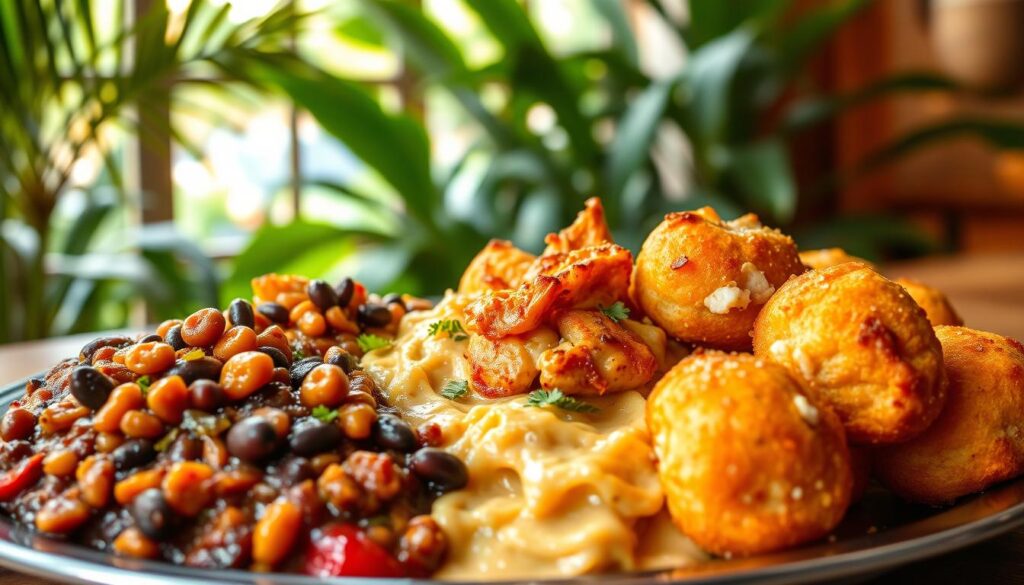
| Staple | Main Ingredient | Typical Usage |
|---|---|---|
| Rice and Beans | Rice, Black Beans | Main meal staple |
| Farofa | Toasted Manioc Flour | Side dish for meats |
| Pão de Queijo | Cheese, Cassava Flour | Snack or breakfast item |
Popular Brazilian Dishes You Can Make
Exploring the vibrant landscape of Brazilian food culture involves diving into some of the country’s most cherished dishes. From hearty stews to sweet treats, these traditional brazilian recipes promise to bring the flavors of Brazil right to your kitchen. You can easily recreate these beloved dishes with a few key ingredients and simple techniques.
Feijoada: A Traditional Stew
Feijoada stands as Brazil’s national dish, celebrated for its rich, robust flavors. This traditional stew features black beans simmered with an array of meats, including beef and pork. Often served with rice, it delivers a comforting meal. Although highly regarded, this dish currently has no ratings, presenting a great opportunity for you to be one of the first to try your hand at crafting this classic dish in your home kitchen.
Moqueca: A Flavorful Fish Stew
Moqueca is a vibrant fish stew that wonderfully captures the coastal influences of Brazilian cuisine. Made with coconut milk, palm oil, and a medley of spices, this dish is a delightful showcase of fresh seafood. The combination of ingredients results in a colorful and aromatic meal that highlights the essence of traditional brazilian recipes.
Brigadeiro: A Sweet Treat
No exploration of Brazilian desserts is complete without brigadeiro. These chocolate truffles, rolled in chocolate sprinkles, are a favorite among locals and visitors alike. With an impressive star rating of 4.8 out of 5, based on 12 ratings, brigadeiros are not only easy to prepare but also guarantee satisfaction for your sweet tooth.

| Dish | Description | Star Rating |
|---|---|---|
| Feijoada | A traditional Brazilian stew made with black beans and various meats. | 0/5 |
| Moqueca | A flavorful fish stew enriched with coconut milk and spices. | Not Rated |
| Brigadeiro | Delicious chocolate truffles rolled in chocolate sprinkles. | 4.8/5 |
The Influence of Indigenous Cultures
Indigenous cultures have greatly impacted Brazilian cuisine, especially through the unique ingredients sourced from the Amazon rainforest. These contributions form a vital part of authentic Brazilian dishes, connecting the present with ancestral culinary practices. Understanding these influences can enhance your appreciation of the rich flavors and traditions that define Brazilian cooking.
Unique Ingredients from the Amazon
Ingredients from the Amazon play a crucial role in shaping authentic Brazilian dishes. Indigenous tribes like the Tupi-Guarani cultivated crops such as cassava, which remains a staple in Brazilian cooking. The pirarucu, a large freshwater fish native to the region, provides significant protein to Indigenous diets. Additionally, exotic ingredients like açaí, tucupi, and jambu showcase the vast biodiversity of the Amazon, enriching the culinary landscape of Brazilian cuisine.
Cooking Techniques Passed Down Through Generations
Traditional cooking methods have been preserved by Indigenous communities, enhancing the cultural depth of Brazilian culinary practices. Techniques such as using clay pots and cooking over wood fires allow modern chefs to connect with their cultural heritage. Such methods bring out unique flavors and textures in Brazilian cuisine. This deep-rooted history ensures that authentic Brazilian dishes maintain a genuine reflection of their origins.
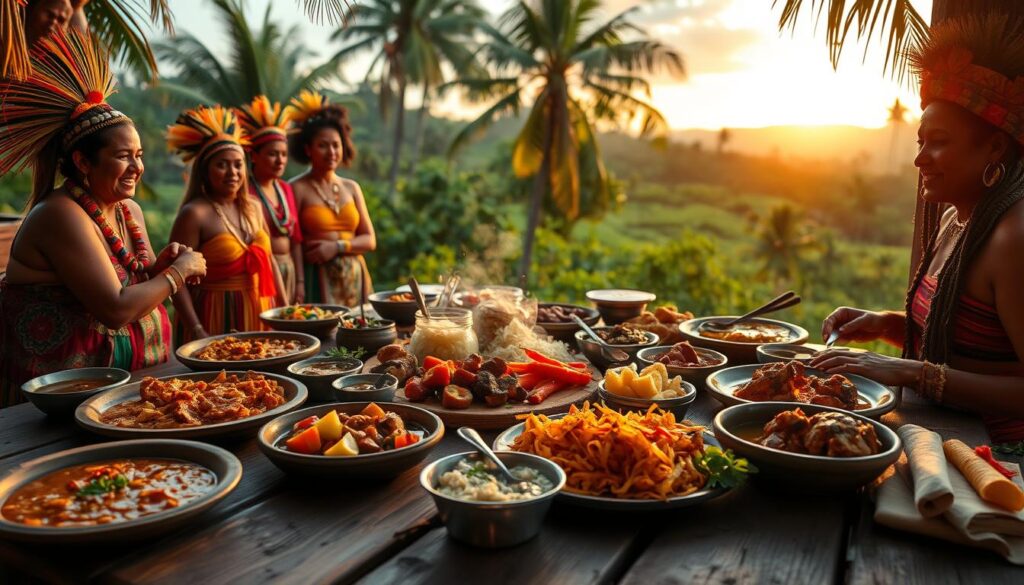
The Role of African Influences
Brazilian gastronomy uniquely reflects a blend of various cultural influences, with African contributions playing a pivotal role. The rich tapestry of flavors and ingredients brought to Brazil by Africans enriches traditional Brazilian recipes, creating distinct dishes that are celebrated nationwide. Understanding these influences reveals the deep connections between Africa and Brazil, particularly in cooking techniques and staple ingredients.
African Ingredients in Brazilian Cooking
Several key ingredients originating from Africa have integrated into Brazilian kitchens. Okra, paired with ingredients like okra, palm oil, and spicy pepper sauces, contributes to dishes like moqueca and acarajé. These elements highlight the African legacy within Brazilian gastronomy, enhancing flavor profiles and providing depth to traditional Brazilian recipes.
How African Heritage Shaped Brazilian Flavors
The intermingling of African cooking methods, such as frying and simmering, with Brazilian ingredients established a distinctive culinary identity. For instance, many Brazilian dishes show resemblance to West African meals, demonstrating the lasting impact of these culinary exchanges. The appreciation for rich, hearty stews and festive dishes like feijoada reflects this history, as they embody the resilience and adaptation of African culinary traditions within Brazil.
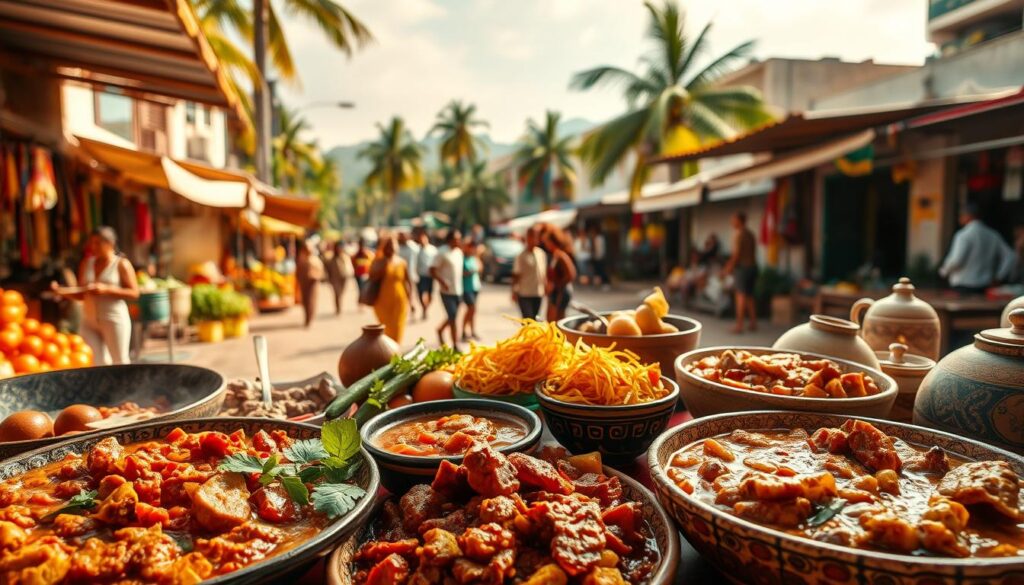
| African Ingredient | Usage in Brazilian Cuisine | Popular Dishes |
|---|---|---|
| Okra | Used in stews and soups | Moqueca, Acarajé |
| Palm Oil | Enhances flavor and richness | Acarajé, Vatapá |
| Spicy Peppers | Seasoning for various dishes | Moqueca, Feijoada |
Brazilian Street Food You Can Try
Immersing yourself in the rich brazilian food culture often begins with exploring its vibrant street food scene. Street vendors across Brazil offer a delightful array of flavors that reflect regional influences and traditional recipes. Two popular favorites that stand out are coxinha and pastel, each showcasing unique tastes that exemplify traditional brazilian recipes.
Coxinha: Savory Chicken Croquettes
Coxinha is a beloved snack that consists of seasoned chicken enveloped in a dough and deep-fried to golden perfection. This delicious treat is shaped like a teardrop, making it both tasty and visually appealing. Enjoyed at any time of day, coxinhas are a staple in Brazilian street food, easily found at both local vendors and restaurants. The rich, savory flavor of the chicken filling combined with the crunchy exterior provides an irresistible experience for your taste buds.
Pastel: Crispy Pastries Filled with Goodness
Pastéis are another street food gem, consisting of thin, crispy pastry filled with a variety of ingredients like meat, cheese, or vegetables. These pastries are deep-fried to achieve a satisfying crunch, making them a popular choice for snacking. Found in street markets and food stalls, pastéis offer a convenient and flavorful way to savor the essence of brazilian food culture. Whether you prefer them spicy or mild, there’s a pastel variation to match your palate.
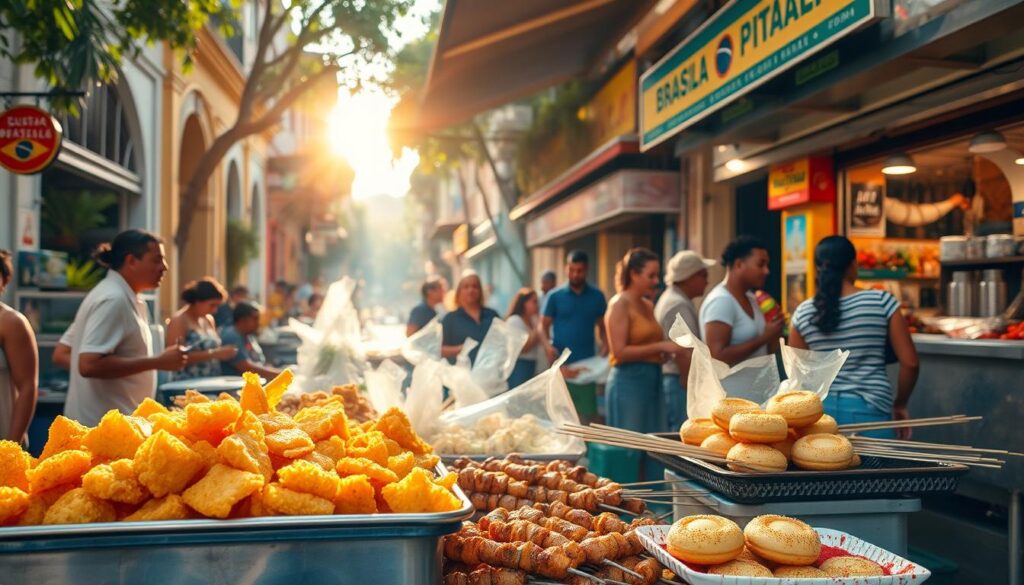
Celebrating Brazilian Festivals Through Food
Food is integral to the vibrant celebrations in Brazil, particularly during significant events like Carnival. Authentic Brazilian dishes are prepared to bring people together, with flavors and traditions that reflect the country’s rich cultural landscape. Festivals create a unique opportunity to enjoy and share traditional meals that honor Brazilian culinary traditions.
The Role of Cuisine in Carnival
Carnival holds a special place in Brazilian culture, especially in Rio de Janeiro, where it is celebrated from February 25 to March 5. This festive period features lively samba music, parades, and, most importantly, an array of delicious foods. Dishes such as feijoada, moqueca, and brigadeiros grace festive tables, showcasing the diverse culinary influences of Brazil. These meals are not merely sustenance; they embody the spirit of community and cultural pride, inviting everyone to indulge and celebrate.
Festive Dishes for Celebrating New Year
As the New Year approaches, Brazilian families prepare various special foods to symbolize hopes for prosperity and luck. Lentils are served, as they are believed to bring financial fortune in the coming year. This tradition aligns with the country’s emphasis on sharing meals with loved ones, reinforcing the value of familial ties and celebration. Authentic Brazilian dishes such as seafood and vibrant salads often accompany the festivities, ensuring a memorable culinary experience as you ring in the new year.
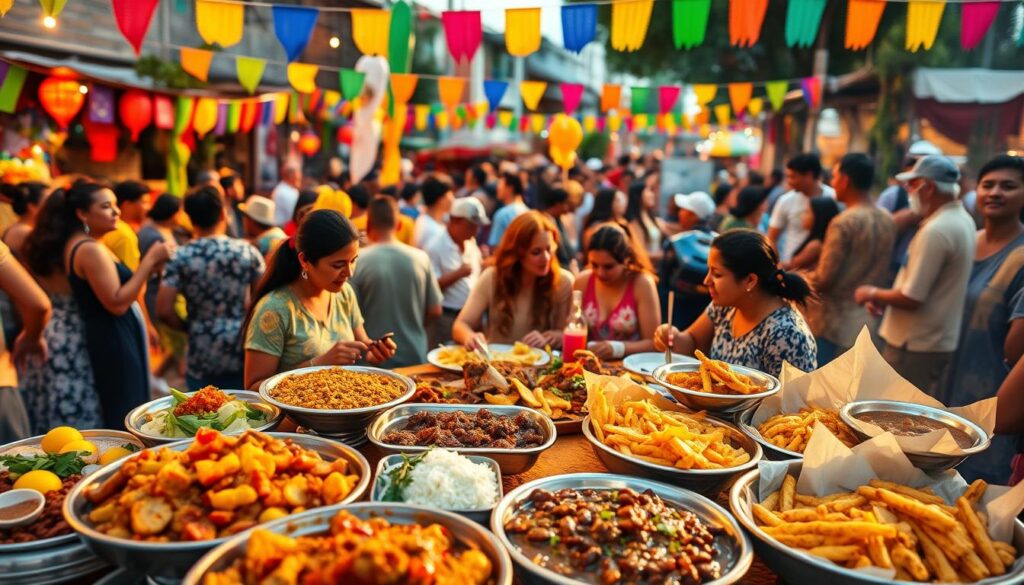
| Festival | Date | Location | Signature Dishes |
|---|---|---|---|
| Carnival | February 25 – March 5 | Rio de Janeiro | Feijoada, Moqueca, Brigadeiro |
| New Year | January 1 | Nationwide | Lentils, Seafood, Salads |
| Festival de Cachaça | Mid-August | Paraty | Samba snacks, Local cuisine |
| Semana Santa | April 16 – 17 | Nationwide | Seafood dishes, Traditional sweets |
Essential Cooking Techniques in Brazilian Cuisine
Understanding the foundational cooking techniques in Brazilian gastronomy can elevate your traditional brazilian recipes to new heights. Two standout methods are grilling, specifically through the art of churrasco, and slow cooking, both essential for capturing the rich flavors and culinary history of Brazil.
Grilling: The Brazilian Churrasco Experience
Grilling is a celebrated technique in Brazilian cuisine, with churrasco presenting a unique barbecue style. This method emphasizes various cuts of meat, such as picanha, which is popular for its tenderness and flavor. Typically, the grilling process will include:
- Marinating meats in spices like cumin and fresh herbs such as cilantro and green onions.
- Using skewers to hold meat, which allows for even cooking over an open flame.
- Serving meats continuously, creating an engaging dining experience with family and friends.
Slow Cooking for Flavorful Results
Slow cooking plays a vital role in traditional brazilian recipes, allowing ingredients to meld their flavors over time. Dishes like feijoada benefit tremendously from this method, as the stew of black beans and various meats becomes rich and hearty after hours of simmering. The process often involves:
- Soaking black beans overnight to ensure they are tender and flavorful.
- Incorporating a mix of salted meats to enhance the depth of flavor.
- Using a pressure cooker, commonly found in Brazilian households, to save time while still achieving delicious results.
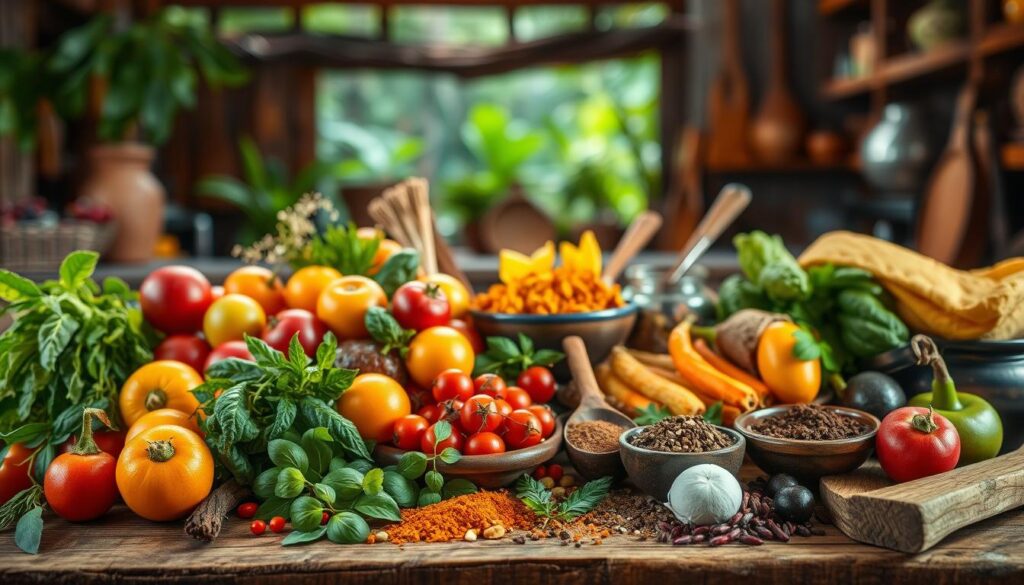
Tips for Stocking Your Brazilian Pantry
Building a well-stocked pantry is essential for making authentic Brazilian dishes that capture the vibrant flavors of this diverse cuisine. Knowing which ingredients to keep on hand will significantly enhance your cooking experience. Below, you’ll find some must-have staples that form the basis of many traditional recipes.
Must-Have Ingredients for Authentic Dishes
- Rice: Long grain white rice is a staple in Brazilian cuisine, while brown rice serves as a healthier alternative.
- Black Beans and Pinto Beans: Black beans are especially popular in Rio, but pinto beans hold their ground as the most commonly consumed throughout Brazil.
- Yuca Root: Known as the “mother of Brazil,” yuca is versatile and used to make yuca flour (farinha de mandioca), which is essential for dishes like farofa.
- Sweet Condensed Milk: This rich ingredient is vital for many desserts, especially brigadeiros, the beloved chocolate truffles.
- Tapioca Starch: Derived from yuca, tapioca starch is used in Pão de Queijo, a must-try Brazilian cheese bread.
- Cachaça: This liquor is the key ingredient in caipirinhas, reflecting its growing popularity in the United States.
- Linguiça Calabresa: This smoked sausage adds depth to dishes like feijoada.
Where to Find Brazilian Products in the U.S.
Finding authentic Brazilian products has become easier in recent years. Specialty Latin markets and major grocery stores often feature sections dedicated to Brazilian cuisine. Here’s a handy guide to help you locate these essential ingredients:
| Ingredient | Where to Find |
|---|---|
| Rice (Long Grain White) | Grocery Stores / Latin Markets |
| Black Beans | Latin Markets |
| Yuca Flour | Online Retailers / Specialty Stores |
| Sweet Condensed Milk | Major Grocery Stores |
| Tapioca Starch | Latin Aisle of Grocery Stores |
| Cachaça | Liquor Stores / Grocery Stores |
| Linguiça Calabresa | Latin Markets / Butcher Shops |
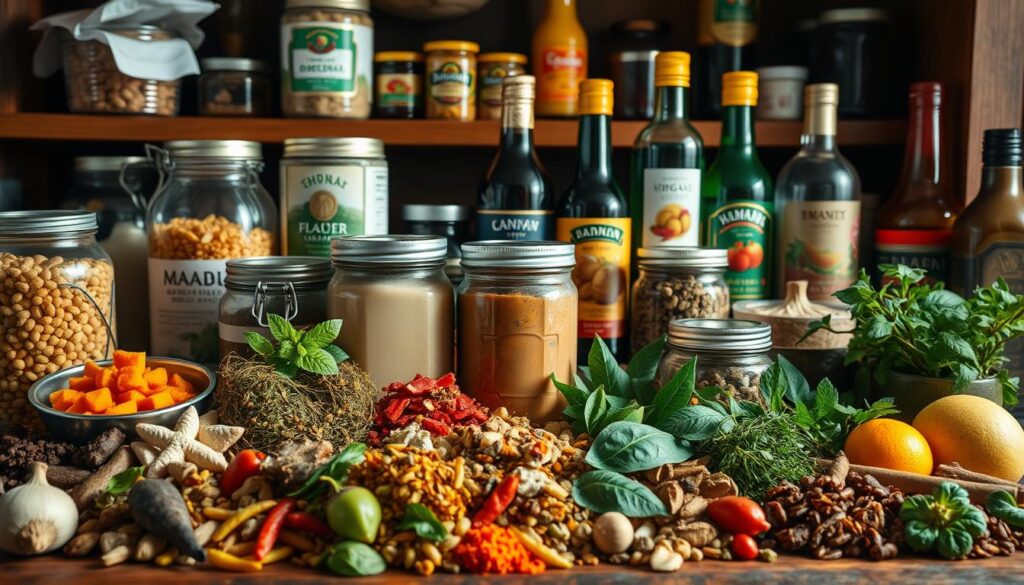
With these ingredients in your pantry, you’ll find it easier to prepare a variety of authentic Brazilian dishes that reflect the rich cultural heritage of Brazil.
Embracing Brazilian Spices and Flavors
Brazilian gastronomy is a vibrant tapestry woven from diverse culinary traditions. Fresh herbs play a crucial role in enhancing the flavor profiles of many dishes. Herbs like cilantro and parsley not only brighten up recipes but also provide essential aromatic qualities that are characteristic of Brazilian food culture. Understanding the role that these fresh ingredients play can elevate your home cooking and bring the taste of Brazil to your kitchen.
The Importance of Fresh Herbs
Incorporating fresh herbs into your Brazilian dishes can make a significant difference. You will often find herbs used in marinades, sauces, and garnishes, adding complexity and depth to common recipes. Key herbs in Brazilian cuisine include:
- Cilantro: Frequently used in salads and cooked dishes.
- Parsley: Offers a fresh taste that complements hearty meals.
- Dried oregano: A staple in savory stews and sauces.
Finding Balance with Heat and Sweetness
The harmony between heat and sweetness is a defining feature of Brazilian gastronomy. Many traditional dishes skillfully meld spicy hot peppers with the natural sweetness of tropical fruits, creating complex and enjoyable flavor combinations. For example:
- Moqueca: A savory fish stew that combines coconut milk with a hint of heat from peppers.
- Acarajé: A fried bean cake filled with seasoned shrimp, showcasing the blend of flavors.
- Tropical fruit drinks: Refreshing beverages often feature fruits like açaí, mango, and passion fruit, balancing tartness and sweetness.
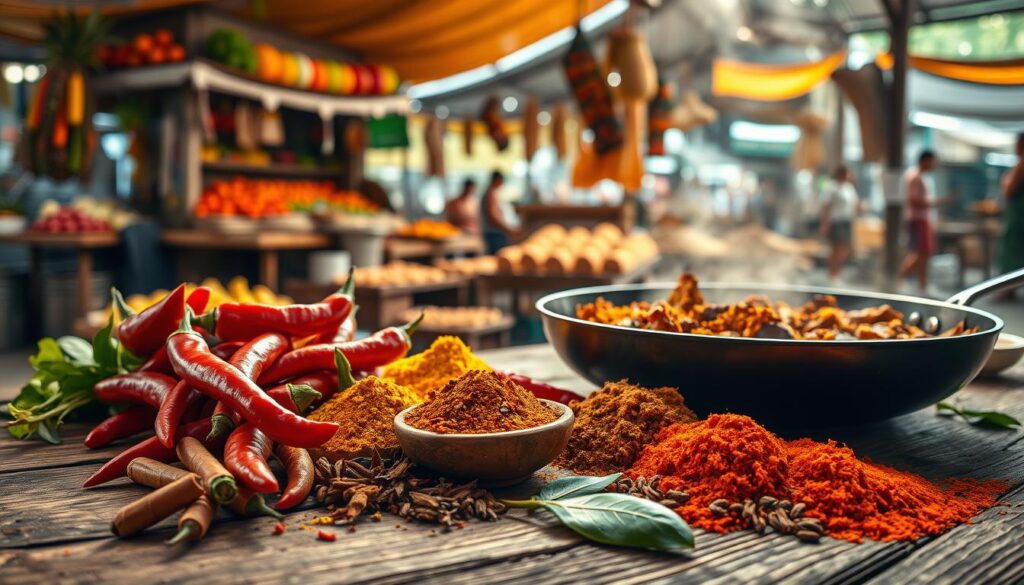
Pairing Drinks with Brazilian Cuisine
Exploring the vibrant world of Brazilian food culture goes beyond just the food on your plate. Drinks play a crucial role in enhancing the culinary experience. Pairing traditional beverages with authentic meals can elevate your dining experience to new heights. Embracing both the spirit of Brazil and its exquisite flavors leads to unforgettable combinations.
Cachaca: The Soul of Caipirinhas
Cachaca, a distilled spirit made from sugarcane, stands as an icon in Brazilian food culture. It serves as the foundation for the nation’s beloved cocktail, the caipirinha. This refreshing drink typically combines fresh lime, sugar, and ice, creating a dazzling balance of acidity and sweetness. The vibrant nature of caipirinha makes it a versatile companion to various dishes. From churrasco, featuring juicy sirloin steak, to moqueca, a creamy tomato-based fish stew, the drink’s characteristics enhance the bold flavors of traditional Brazilian recipes.
Brazilian Wines Worth Exploring
Brazilian wines are gaining recognition worldwide, particularly those coming from the Serra Gaúcha region. The rich landscape produces wines that complement the array of flavors found in traditional Brazilian dishes. When enjoying feijoada, Brazil’s famous black bean stew, medium-bodied red wines—like Carmenère or Merlot—offer a delightful pairing. The array of fillings used in dishes like coxinha allows for diverse wine pairings, such as fruity Zinfandel or silky Petite Sirah for red lovers. Adventurous palates can explore light whites like Alsatian Riesling, which refreshingly balance moqueca’s spiced creaminess.
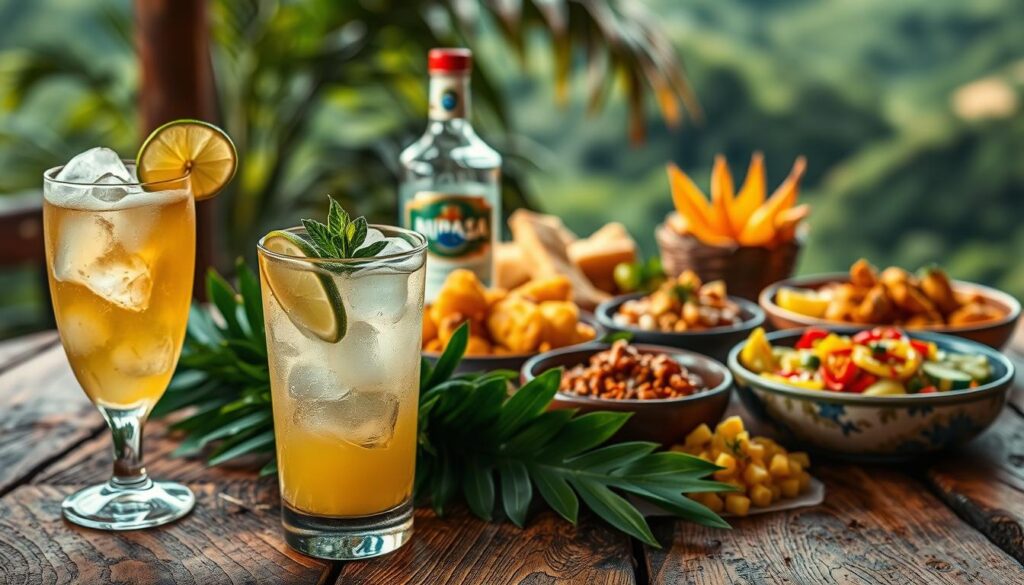
Exploring Brazilian Desserts
Brazilian cuisine boasts an impressive array of desserts that highlight the country’s rich heritage and diverse ingredients. These traditional Brazilian recipes often use tropical flavors and techniques that delight the palate. From creamy flan to the unique quindim, discover the sweetness that defines Brazil’s dessert scene.
Flan: A Creamy Delight
Flan has become a beloved dessert across Brazil, adored for its creamy texture and rich caramel sauce. This custard-based sweet treat is often a staple at gatherings and family celebrations. In traditional Brazilian recipes, flan is made using a blend of milk, sugar, eggs, and vanilla, creating a perfect ending to any meal. The silky smooth layers of flan perfectly capture the essence of Brazilian cuisine.
Quindim: Coconut and Sugar Bliss
Quindim is another classic dessert that highlights Brazil’s love for coconut. This sweet dish features a delightful combination of egg yolks, sugar, and shredded coconut, resulting in a vibrant yellow treat that melts in your mouth. With its rich ingredients and a hint of vanilla, quindim represents the tropical allure often found in traditional Brazilian recipes. Its glossy finish and sweet aroma make it a popular choice during festivals and special occasions, adding a touch of bliss to any celebration.
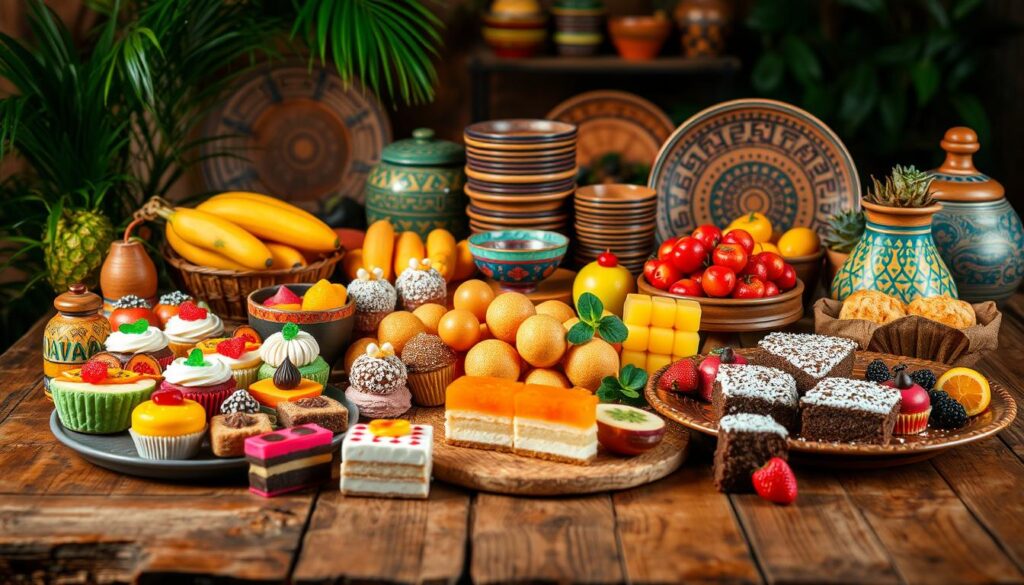
Vegetarian and Vegan Options in Brazilian Cuisine
Brazilian gastronomy embraces a rich array of vegetarian and vegan options, allowing everyone to savor authentic Brazilian dishes. Many traditional favorites can be easily adapted, ensuring that plant-based diets are inclusive and flavorful. With unique local ingredients and creativity, you can explore these delicious alternatives.
Plant-Based Adaptations of Traditional Dishes
Incorporating plant-based adaptations into your meals can bring the vibrant tastes of Brazil right to your table. For instance, moqueca, traditionally a fish stew, can be transformed using vegetables and plant-based proteins while maintaining its signature seasoning. Other options include:
- Vegetarian feijoada: This classic stew can be made with black beans, vegetables, and seasoning without the meat.
- Vegan farofa: A flavorful accompaniment made with cassava flour that can be adapted to be entirely plant-based.
- Pão de queijo: While typically made with cheese, you can find or create dairy-free versions for a delightful snack.
Flavorful Alternatives for Everyday Cooking
Everyday Brazilian dishes can shine with vegetarian and vegan innovations. Staples like rice and beans stay consistent in plant-based diets, providing essential nutrients and flavor. Consider preparing:
| Dishes | Vegetarian/Vegan Adaptation | Calories (per serving) |
|---|---|---|
| Cuzcuz Nordestino | Served with colorful vegetables and herbs | 220 |
| Geladinho | Made with local fruits and plant-based milk | 150 |
| Curau | Veganized with plant-based milk | 180 |
With options like these, you can easily enjoy a variety of delicious and nutritious meals while celebrating the essence of authentic Brazilian dishes. The culinary landscape of Brazil welcomes everyone, making vegetarian and vegan adaptations not just possible but downright delightful!
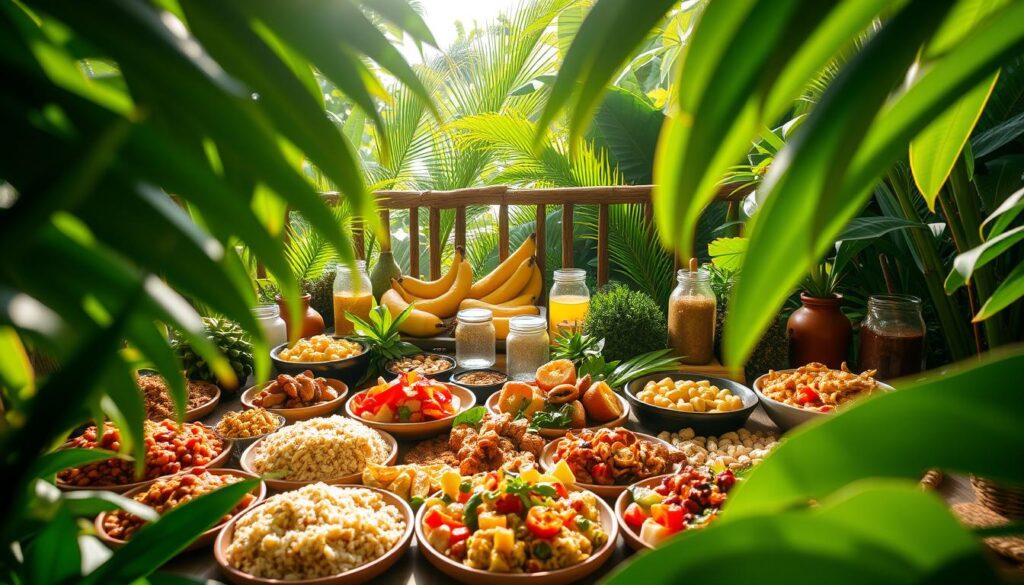
Hosting a Brazilian Dinner Party
Hosting a Brazilian dinner party can immerse your guests in the warmth and vibrancy of Brazilian food culture. Start by setting a rustic atmosphere, using vibrant colors reminiscent of the Brazilian flag and tropical flowers like hibiscus and orchids. Think of incorporating reggae or samba music to elevate the festive spirit.
Creating a Rustic Brazilian Atmosphere
Your dinner table should reflect the essence of Brazil. Use colorful tablecloths and handmade pottery for serving dishes. For lighting, consider candles to create a cozy environment. The incorporation of Brazilian music genres, such as Bossa Nova and Funk, enhances the overall ambiance, ensuring your guests feel the lively spirit of a true Brazilian gathering.
Menu Suggestions to Impress Your Guests
When it comes to the menu, focus on a blend of traditional Brazilian recipes that showcase both flavors and convenience. Start with appetizers like Pão de Queijo and Coxinha, which are classic must-haves. For the main course, serve Feijoada, Brazil’s beloved black bean stew, or a vegetarian version with seasonal vegetables. Treat your guests to a Rodizio-style experience, featuring grilled meats such as Picanha and chicken hearts.
To accompany the meal, the Caipirinha stands out as Brazil’s national cocktail, crafted with cachaça, lime, and sugar, ensuring that each drink reflects quality and authenticity. Don’t forget to include popular Brazilian beers like Skol and Brahma for those who prefer a cold brew. For dessert, Brigadeiros are a delightful way to end the meal, capturing the sweet essence of Brazilian celebrations.

Learning Through Brazilian Cooking Classes Online
Embracing Brazilian cuisine at home has never been more accessible, thanks to the myriad of online cooking classes available. Participants can immerse themselves in traditional Brazilian recipes, guided by experienced chefs who share insights into authentic techniques and ingredients. These classes offer a unique opportunity to not only learn how to cook but also to appreciate the rich cultural heritage behind each dish.
Finding the Right Class for You
Choosing the right online cooking class can elevate your culinary skills and deepen your understanding of Brazilian flavors. Look for classes that offer:
- Comprehensive content, including 2 hours of HD video.
- A structured curriculum with 17 lessons covering essential techniques.
- Hands-on experience with 11 different recipes, incorporating staple ingredients like beans, rice, and cassava.
- Downloadable recipe books available in both English and Spanish.
- Options for those with dietary restrictions, ensuring many recipes are gluten-free.
Benefits of Cooking with Brazilian Chefs
Learning from Brazilian chefs provides numerous benefits. Many chefs, such as João Alcantara, have worked alongside high-performance athletes, bringing professional insight into the culinary world. Classes often highlight:
- The importance of using new ingredients like yucca and its culinary potential.
- Access to a platform recognized by prominent culinary authorities, ensuring a high-quality learning experience.
- The convenience of participating from various devices, allowing classes to fit your schedule.
- A relaxed and fun atmosphere, perfect for team-building or a unique date night experience.
With features that cater to all skill levels, online Brazilian cooking classes offer a delightful path to enhance your cooking repertoire and enjoy the delightful flavors of Brazilian cuisine.
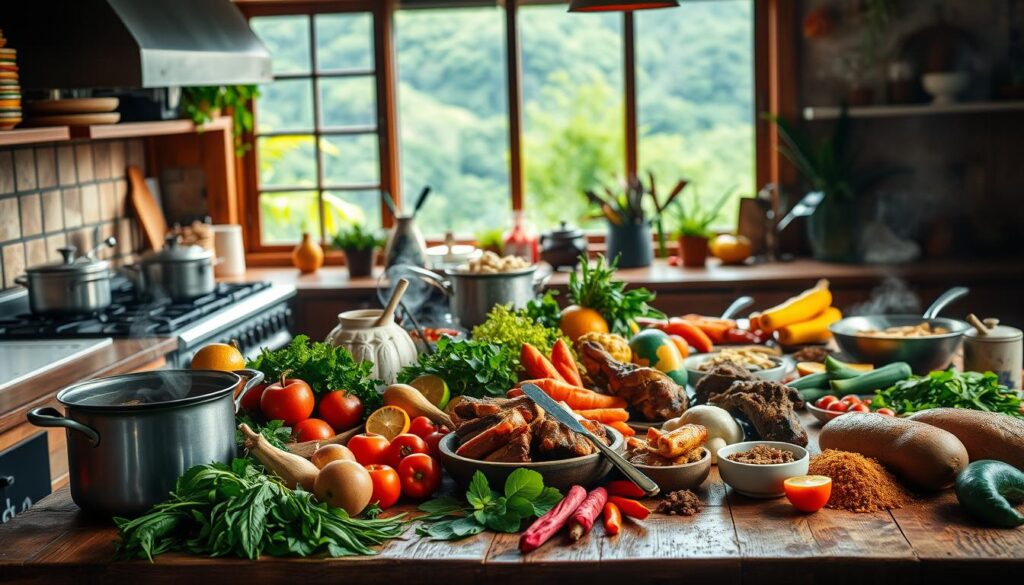
Conclusion: Bringing the Taste of Brazil to Your Table
The journey into Brazilian cuisine is not just about the food; it’s an adventure of flavors that inspires creativity in your kitchen. With an increasing interest in traditional Brazilian recipes across the United States, you’re encouraged to explore the diverse ingredients and cooking methods that make this cuisine so vibrant. By experimenting with these exciting flavors, you will not only enhance your own culinary skills but also enjoy the rich cultural tapestry that each dish represents.
Encouragement to Experiment and Enjoy
As you delve into Brazilian cooking, don’t hesitate to try your hand at classic meals like feijoada or moqueca. Each recipe carries a story, inviting you to discover how these beloved dishes have evolved over time and across regions. Whether you’re grilling, sautéing, or slow-cooking, embrace the process of creation and enjoy the delectable results that can come from even the simplest ingredients.
Discovering New Flavors in Your Kitchen
From the heart of traditional Brazilian recipes to modern interpretations, there is no shortage of inspiration. By sourcing authentic ingredients and honing your skills, you can turn your kitchen into a vibrant representation of Brazil’s rich culinary heritage. So gather your spices, prepare your favorite dishes, and let the joyous flavors of Brazil enhance your dining experience like never before!
